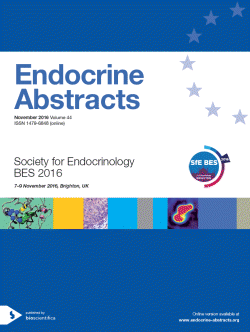
Society for Endocrinology BES 2016
Brighton,
UK
07 Nov 2016 - 09 Nov 2016

Oral Communications
Neuroendocrinology and Reproduction
ea0044oc2.1 | Neuroendocrinology and Reproduction | SFEBES2016
Kisspeptin: A Novel Neuroendocrine Modulator of Sexual and Emotional Processing in Men
Comninos Alexander , Wall Matthew , Demetriou Lysia , Shah Amar , Clarke Sophie , Narayanaswamy Shakunthala , Nesbitt Alexander , Izzi-Engbeaya Chioma , Prague Julia , Abbara Ali , Ratnasabapathy Risheka , Salem Victoria , Nijher Gurjinder , Jayasena Channa , Tanner Mark , Bassett Paul , Mehta Amrish , Rabiner Eugenii , Honigsperger Christoph , Dhillo Waljit
ea0044oc2.2 | Neuroendocrinology and Reproduction | SFEBES2016
MLE4901, a neurokinin 3 receptor antagonist, shows reproductive tract effects and sustained pharmacodynamic activity consistent with HPG suppression after 13 weeks of oral administration in dogs
Coulson Michelle , Hunt Stephen
ea0044oc2.3 | Neuroendocrinology and Reproduction | SFEBES2016
Associations between karyotype and long term health outcomes in adults with Turner Syndrome; The Turner Syndrome Life Course Project
Cameron- Pimblett Antoinette , La Rosa Clementina , King Thomas , Lioa Lih-Mei , Davies Melanie C , Conway Gerard S
ea0044oc2.4 | Neuroendocrinology and Reproduction | SFEBES2016
Heteromers of luteinising hormone and follicle stimulating hormone receptor positively and selectively modulates the LH-induced calcium signalling response
Jonas Kim , Chen Stanford , Huhtaniemi Ilpo , Hanyaloglu Aylin
ea0044oc2.5 | Neuroendocrinology and Reproduction | SFEBES2016
Ipilimumab Hypophysitis – single centre experience of an emerging endocrine diagnosis
Marc Lai Zhuangming , Spain Lavinia , Gore Martin , Larkin James , Morganstein Daniel
ea0044oc2.6 | Neuroendocrinology and Reproduction | SFEBES2016
Dysregulation of the steroidogenic gene network in granulosa cells from women with PCOS
Lerner A , Coates M , Velupillai J , Christopoulos G , Liyanage M , Islam R , Lavery S , Tsui V , Hardy K , Franks S



